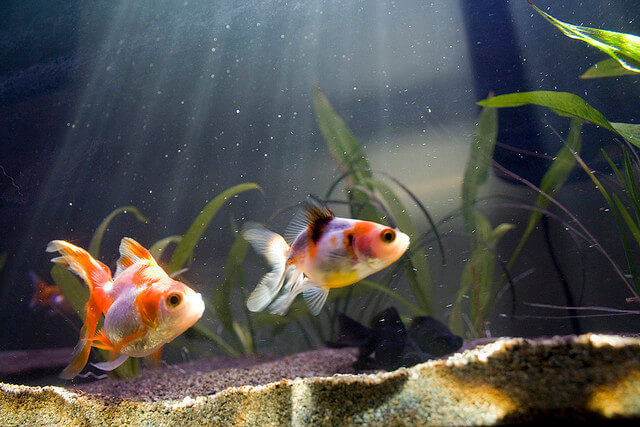The Japanese Ryukin goldfish is a captivating breed with its unique hump, cherry blossom petal tail, and a wide array of color variations. Their elegant appearance and hardy nature make them a favorite among goldfish enthusiasts. Whether in an outdoor pond or an indoor aquarium, the Japanese Ryukin goldfish adds beauty and charm to any aquatic setting.

Ryukin Care Tips
Tank Size:
Japanese Ryukin goldfish require ample swimming space due to their active nature and long fins. A minimum tank size of 20-30 gallons is recommended for a single Ryukin, with an additional 10-15 gallons for each additional fish. A larger tank or pond is even more ideal for their growth and overall well-being.
Water Quality:
Maintaining good water quality is crucial for the health of Japanese Ryukin goldfish. Regular water changes (around 20-30% every 1-2 weeks) help remove toxins and maintain appropriate water parameters. Use a reliable water test kit to monitor ammonia, nitrite, nitrate, and pH levels. The water temperature should be kept between 65-75°F (18-24°C).
Filtration:
An efficient filtration system is necessary to remove waste and debris from the water. A combination of mechanical, biological, and chemical filtration is recommended. Choose a filter that is suitable for the size of your tank or pond and follow the manufacturer’s instructions for maintenance and cleaning.
Diet:
Japanese Ryukin goldfish are omnivorous and have a hearty appetite. Provide them with a balanced diet that includes high-quality goldfish pellets or flakes as the staple food. Supplement their diet with fresh vegetables like peas, lettuce, and spinach, as well as small portions of live or frozen foods such as brine shrimp, daphnia, or bloodworms. Feed them in small portions multiple times a day, ensuring they consume the food within a few minutes to prevent overfeeding.
Avoid Overcrowding:
Japanese Ryukin goldfish are active swimmers and require space to thrive. Avoid overcrowding the tank or pond, as it can lead to stress, aggression, and compromised water quality. Provide adequate swimming space and avoid keeping them with slower-moving or delicate-finned goldfish breeds that may be prone to bullying.
Monitoring Behavior and Health:
Regularly observe the behavior and appearance of your Japanese Ryukin goldfish. Look out for signs of disease, such as changes in appetite, abnormal swimming patterns, frayed fins, or visible signs of parasites. If any issues are detected, take prompt action by quarantining the affected fish and consulting a knowledgeable aquatic veterinarian or fish expert.
Environmental Enrichment:
Provide your Japanese Ryukin goldfish with a stimulating environment. Add live or artificial plants, rocks, and hiding spots to mimic their natural habitat. These elements not only enhance the aesthetics of the tank or pond but also provide places for the fish to explore and seek shelter.
Types of Ryukin Goldfish
There are several types of Ryukin goldfish, each with its own specific characteristics and variations:
- Yamagata Kingyo: This type of Ryukin goldfish is known for its vibrant colors and pronounced hump. It has a single caudal tail fin and a well-rounded body.
- Sabao: The Sabao Ryukin has a slender body shape, a single caudal tail fin, and a relatively smaller hump compared to other varieties.
- Tamasaba: Tamasaba Ryukins are characterized by their metallic scales, bright colors, and a single caudal tail fin. They have a more streamlined body shape.
Compatibility and Tank Mates
When considering tank mates for the Japanese Ryukin goldfish, it’s important to be cautious. While Ryukins are hardy and can coexist with other goldfish breeds, they may become territorial or aggressive towards slower-moving fish with delicate fins. It is advisable to keep them with other active and robust breeds like the oranda, lionhead, or Ranchu goldfish, as they are more likely to establish a harmonious environment.
What Makes a Ryukin Unique
The Japanese Ryukin goldfish is a highly sought-after breed among goldfish enthusiasts due to its unique appearance. Originating from the Ryukyu Islands, this goldfish exhibits several distinctive features that set it apart from other goldfish types.
Body Shape and Prominent Hump
The Japanese Ryukin goldfish has a body shape similar to the fantail goldfish, characterized by a round and elongated body. However, what truly distinguishes the Ryukin is the prominent hump on its back, which elevates the dorsal fin. This hump is a key feature of the breed and gives it an elegant and regal appearance. The size and prominence of the hump can vary among individual fish, adding to the uniqueness of each Ryukin.
Cherry Blossom Petal Tail
One of the most stunning features of the Japanese Ryukin goldfish is its long caudal tail fins, which can have three or four lobes. This tail structure creates a resemblance to cherry blossom petals, enhancing the overall visual appeal of the fish. The flowing and graceful movement of the tail adds a sense of elegance and beauty to the Ryukin goldfish.
Color Variations
The Japanese Ryukin goldfish offers a wide range of color variations, making it even more appealing to goldfish enthusiasts. Some of the common color combinations include:
- Solid colors: This includes deep red, orange, white, blue, and black, providing a striking and eye-catching appearance.
- Bicolor: Ryukins can have combinations of red and white, red and black, or orange and white, creating a beautiful contrast and pattern on their body.
- Calico: Calico Ryukins have a mix of three or more colors, often including shades of red, white, black, orange, and yellow. The calico pattern can vary greatly among individual fish, making each Ryukin unique.
Reviewed By: Tim Winter

Tim Winter has a strong affection for pets and wildlife. His years of experience caring for various types of pets has led him to share his knowledge with others on the best practices in pet care. Tim holds a Bachelor of Science from the University of Oregon School of Journalism and Communications.
